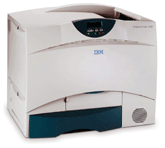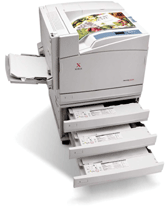When it comes to adding red, yellow or blue to government printing, the primary color is green'as in, is it affordable and fast enough to justify replacing a monochrome workhorse?Increasingly, agencies are indeed adding color'and the instruments of choice are not cheap, slow, expensively maintained ink-jets, but durable, sub-$3,000 laser printers that can be networked and shared so efficiently that nearly every workgroup can afford one.Vendors say color is now used for more than just its original killer app: handouts of Microsoft PowerPoint presentations. Among the applications most in demand is color highlighting in training manuals and spreadsheets. 'In some parts of the government, they are looking for quality photo images for identification cards,' said Keith Shaw, director of marketing for vendor Oki Data Americas Inc., citing the Mexican government's plan to print cards on special tear-resistant media.[IMGCAP(2)] The U.S. armed services use Oki Data printers to provide soldiers with color maps. Lexmark International Inc. says the Air Force uses its printers to reproduce aerial views and other photographs for pilots. The city of Wichita, Kan., uses four Xerox Phaser 7300s to pump out its annual budget, as well as maps and everyday office documents in four departments. Xerox Corp. also counts the Navy, Forest Service and intelligence agencies among its large users. The intelligence users 'actually won't tell us what they are doing with them, but they bought thousands last year,' said Ken Knewpper, Xerox's product marketing manager.Color has come a long way on laser and LED printers, especially since the advent about three years ago of single-pass technology'also known as tandem or in-line printing. Crayonlike solid-ink cartridge printers, pioneered by Tektronix Inc. and acquired by Xerox, were single-pass upon their introduction years earlier.Single-pass technology lets the four primary colors fuse to paper in one clean pass, rather than needing repeated passes for each color toner. The result: a leap in per-minute page rates from low single digits up to around 30. At the same time, the price difference between printing monochrome pages on color printers instead of black-and-white printers has nearly disappeared. 'We've brought the cost per page down to where it's comparable to our monochrome printers,' said David Steinforth, a Lexmark marketing manager.The color market grew 25 percent in the past year, according to market researcher Gartner Dataquest of San Jose, Calif. The dominant player, by far, is Hewlett-Packard Co., which shipped 51 percent of the 314,816 color units sold last year in the United States. Other leaders include Xerox, with 19 percent; Minolta-QMS USA Inc., with 13 percent, and Lexmark, with 6 percent. Still, the numbers represent about a tenth of the ink-jets, the dominant color technology thanks to its much lower start-up costs, Gartner principal analyst Peter Grant said.Printer manufacturers often accommodate security concerns with personal identification numbers or smart cards to activate printing. Alternatively, some agencies lock away printer hard drives each night or buy diskless printers to avoid data theft altogether.The accompanying chart shows only color printers that come with a network card. Excluded are ink-jets and multifunction products.When comparing features, bring a jaundiced eye to stated resolutions. Most printers have native resolutions of 600 by 600 dots per inch, or 600 by 1,200 dpi on the outside; anything higher is simulated with software interpolation that can degrade the image'but most people can't see the difference anyway.Duty cycles typically are figured for letter-size paper and might not reflect your use patterns or mix of black-and-white and color. And speeds are often much slower than claimed.Are multifunction copiers'which also fax, print and scan'a better alternative? These units cost around $3,000 more than color printers and generally suit organizations with a Kinko's-like need for fast, high-volume print jobs they otherwise would outsource. Multifunction products' sales growth is slower than that of color printers, and they are losing their speed advantage. 'The standalone printers today are as fast as these copiers,' Grant said.Still, multifunction products have a lower page cost at high volumes and have longer duty cycles and usually more robust service, he said.The trick is figuring out where to best use them. Maj. Keil Hubert, commander for the Air National Guard's 136th Airlift Wing in Fort Worth, Texas, is gradually replacing a mix of multifunction, color and laser printers from several vendors with Lexmark models because of competitive pricing and the opportunity to spread consumables across machines with a common imaging engine.Hubert runs centrally located multifunction printers for high-volume applications, such as the wing's newsletter, pairing them with single-purpose printers for simultaneous processing of large jobs. Small workgroups get color and monochrome printers.In the process, Hubert has eliminated fax machines and smaller copiers. 'We have been trying to drive people off ink-jets,' he said, because the wing's weekend-a-month crunch periods eat cartridges faster than usual, driving up page costs.
IBM's Infoprint Color 1220, priced at $2,476, is capable of 1,200- by 1,200-dpi resolution and 20 ppm in monochrome or color.
The Xerox Phaser 7700DN is a single-pass laser with 600-by 1,200-dpi resolution rated to print 22 ppm in monochrome or color. It's priced at $6,999.








